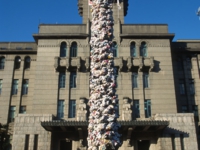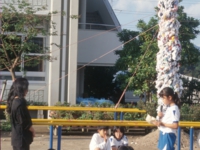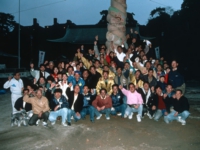「NAWA LINK HISTORY」
NAWA LINK HISTORY

1992年4月
大津市比叡平小学校3年生の授業で古着をもちより縄ないをおこなう。子供たちがつくった縄を未完でツインのNAWA彫刻に組み込み完成させ、ツインのうちひとつの彫刻はブラジル国立美術館に所蔵。もうひとつの彫刻は日本にある。(アーティスト所蔵)生命と題する子供たちが描いた絵と文をブラジリアの貧民街の子供たちに披露する。
1992年5月
ブラジリアの貧民街の住民、特に子供や老人たちと古着を利用して縄ないをおこな う。縄ロジイを発信。世界のアーティストが集い、地球環境を考え示唆するブラジル のブラジリアで開催されたOMAMEプロジェクト環境会議の一環としておこなう。国際交流基金助成。
1992年5月
NAWAロジイを地球環境声明に。ブラジル リオデジャネイロ アースサミット参加。 古着の縄を世界から集まった100人のアーティストたちと一本一本つなぎあわせ、 NAWA LINKをつくる。太古の楽器といわれる、うなり木(縄の端に棒木を結びつけ、 縄をもって回転させて音をだす)と縄ロジイの詩で音楽をつくり、アーティストたちみんなでNAWA LINKをもって踊る。NAWAパフォーマンスをおこなう。
1995年11月
KOBE ROOTS 縄-心の絆 阪神大震災後の復興のために、神戸市御影町弓弦羽神社 で、被災された延べ500人の市民の人々とともに、大縄をない、境内に立て上げる。 全国から一万着の古着とメッセージがよせられ、古着をつなぎ、高さ8m太さ1mの大縄 の塔が完成。
1996年1月
KOBE ROOTS NAWAアートセレモニー 鎮魂の縄1,000人が見守るなか、大縄の塔に点 火。翌朝、NAWAの灰を集め、心の記憶として作品を残す。
1996年6月
NAWA LINK IN QUARRATA ITALY、ピストイア高等学校の学生たちといっしょに、地 場産業のリサイクル布フェルト材を用いて、NAWAインスタレーションをクアラッタ市 の広場に完成。 PEOPLE'S NAWA BY PEOPLE IN QUARRATA 50人の市民と市民広場で古着をつないで、 NAWAパフォーマンスをおこなう。イタリア、クアラッタビエンナーレ招聘。
1996年8月~1997年6月~9月
NAWA LINK IN GERMANY ドイツの学生達といっしょに、古着をつないで直径2m×高 さ8mの太縄を土中に立てる。カッセル市アシュロット公園 “インサイド”国際美術展・パラレルドクメンタにインスタレーションワークを制 作出品。DAAD基金助成。
1998年4月~11月7・8日
島根県湖陵町・こりょうエコ・リンク98 湖陵町民で大縄柱のモニュメントを立ち上げる。
1999年4月~8月
米子商工会議初青年部 鳥取県西部12市町村広域連携を目指し、みんなでつくる 2万5千枚古着Tシャツで高さ10m直径1.4m 国引きの縄柱を立てる。
2000年7月~12月
縄バイタルリンク2000京都 21世紀ー新地軸 古着Tシャツ約1万枚で高さ11m直径1,2m縄の塔を完成12月25日京都市庁舎前広場に建立、アートセレモニーで点火。日本芸術文化振興会基金助成
2004年2月~8月
岡山県 玉野みなと芸術フェスティバルにて
八木マリヨの縄バイタルリンクプロジェクト
”Uno! Andiamo avanti”
主催 玉野みなと芸術フェスタ実行委員会
2009年 アルルステック フランス
NAWA 彫刻大きさ;2,3m 高x10-20cm 直径
材料;カタルニア伝統織物 3種類の色違い木綿生地1,8m
幅0,6m 長さx 3枚
鉄性支柱2,3m 高x2cm 直径,足部0,6mx0,6m
地域に自生する植物、木の実、花、ハーブ等
2010年5月5日~7月18日
男木島ーYou & I 汝我(なわ)の塔 地軸2010
「人の絆と地域風土」環境力の結集
サイズ; 高さ7m 太さ90cm~30cm 周囲2m
素材: 天然繊維古着、木屑、 ハーブ、檜丸太、男木島の干雑草と玄武岩石
制作; 八木マリヨ+縄バイタルリンク チーム


1992.4
JAPAN AND BRAZIL Students of Hieidaira Elementary School in Japan made Nawa-rope with their worn-out T-shirts. They also produced drawings and poems about life. These drawings were later shared with Brazilian children living in a poor area, who also made drawings and produced Nawa-rope out of their old, ragged T-shirts. Mariyo Yagi made a monumental two-part Nawa-rope sculpture, entitled "DNA of Culture Brazil and Japan", using the T-shirt Nawa-rope produced by the children as part of the sculpture. One-half of the sculpture is now in the Brasilia Museum of Modern Art Permanent Collection, and the other part remains in the artist's collection.
1992.5
RI O DIJANERO and BRASILIA, BRAZIL MariyoYagi presented her philosophy " Nawalogy" in Brasilia at the "Environment and Survival" Conference and Exhibition, part of the Omame Project, which involved 100 artists from all over the world. Her participation was funded by the Japan Foundation. At the Rio Earth Summit, 100 international artists joined together to perform Nawa-link spiraling dancing and singing, and to create wind-sounds by swirling the Nawa-rope with wood in large cirlces through the air. "Nawalogy" and its philosophy of interconnection of humans with nature and civilization was an important influence on the conference and its attendees.
1995.11
KOBE ROOTS, JAPAN 500 Kobe citizens who suffered from the Great Hanshin earthquake collaborated to create a huge Nawa-rope column made of 10,000 old T-shirts. "The shirts formed a human body or a human soul," the artist explained. Each shirt was inscribed with a message of encouragement, sent from all over Japan, to help re-vivify the earthquake survivors. This Nawa column, titled "Kobe Roots,"( 8m high X 1m diameter) was erected by the earthquake survivors as a unifying symbol at Yuzuruha Shrine in Kobe. "Kobe Roots" was born from the collective strength of communities.
1996.1
KOBE ROOTS NAWA art ceremony, JAPAN Mariyo Yagi orchestrated a ritual burning of "Kobe Roots" as a form of Requiem to console the souls of those who died in the earthquake. Many earthquake survivors said that this burning ritual helped them to be at peace with those who perished, to accept their own survival without guilt, and to acknowledge the importance of their bondedness to one another. Out of the ashes of the burnt Nawa-column, Mariyo Yagi produced works of art as a physical symbol of the human connection that remains after a transformative event.
1996.6
NAWA LINK IN QUARRATA , ITALY Students of Pistoia High School, Italy, collaborated to create Nawa-rope made with recycled textile materials from the local industry. Mariyo Yagi was invited for the 2nd Quarrata Biennnale and created a Nawa installation in the plaza of Quarrata city. 50 Quarrata citizens performed a dance of intertwining their old T-shirts into Nawa-rope.
1997.6-9
NAWA LINK IN KASSEL, GERMANY Mariyo Yagi received a DAAD Grant from the German government to participate in the INSIDE International Art Exhibition / Parallel Documenta Kassel, Germany. German students collaborated to erect a Nawa column ( 8m high X 2m diameter) made with 7,000 old T-shirts and hay at Ashrott Park in Kassel,Germany. A catalogue documenting the project was published by Inerational Public Art Co. Ltd.
1998.4-11
ECO-LINK KORYO, SHIMANE, JAPAN The town of Koryo-cho, Shimane, Japan invited Mariyo Yagi to help them construct a Nawa-column made with 10,000 worn T-shirts entitled "ECO-LINK KORYO". "Nawa is a symbol of connectedness between nature and human life," said Mariyo Yagi, and the project with the people of Koryo-cho emphasized preservation of the environment, recycling, and the preciousness of nature.
1999.4-8
UNIFICATIN THROUGH MYTHOLOGY, JAPAN The Chamber of Commerce of Yonago-Totori region invited Mariyo Yagi to help them unify the 12 cities of their area. Historically, these cities were part of the same unified community, and the more recent governmental divisions into individual cities had created an environment of competitiveness among neighbors. Together with Mariyo Yagi's guidance, the people of the 12 cities joined together to create a Nawa-column made of 25,000 worn T-shirts. Entitled "Kunibiki", (10m high x 2m diameter), named after a story from the ancient Izumo mythology which they shared,"Kunibiki" became a contemporary symbol of their community bonds, past and present.
2000.7-12
NAWA-VITAL LINK 2000, KYOTO, JAPAN The project Nawa Vital Link 2000 Kyoto brought together 10,000 people to collaboratively produce a Nawa column (11m x 1,2m diameter) called "The 21st Century-The New Earth Axis". The Nawa column was made with 10,000 worn T-shirts inscribed with individual messages for the 21st Century. The Nawa column was erected in Kyoto City Hall Plaza. Using only sunlight and a magnifying glass, fire was created and used to ignite a ritual burning of the entire column. "Because Kyoto has the most traditional culture and is the most conservative city in Japan, I wanted to create a new stream of fresh air through this project to revitalize Kyoto." Mariyo Yagi was able to collaborate with the Kyoto Fire Brigade, who gave a special exception to allow the burning ritual, and became a part of the performance as they stood by in their red fire trucks spraying a mist of water while the fire ritual was performed.
2004.Feburualy 8th
Mariyo Yagi's Nawa vital link project "Uno Andiamo Avanti"
was held in Tamano Minato Art Festival Okayama prefecture Japan














